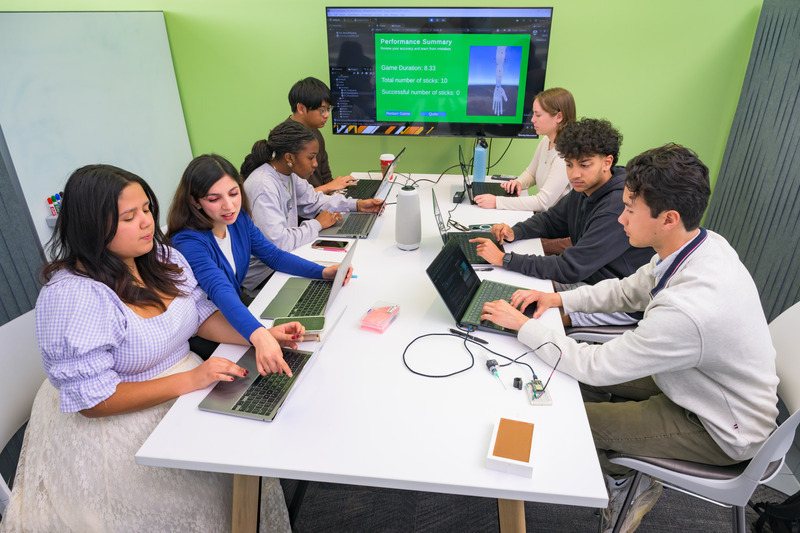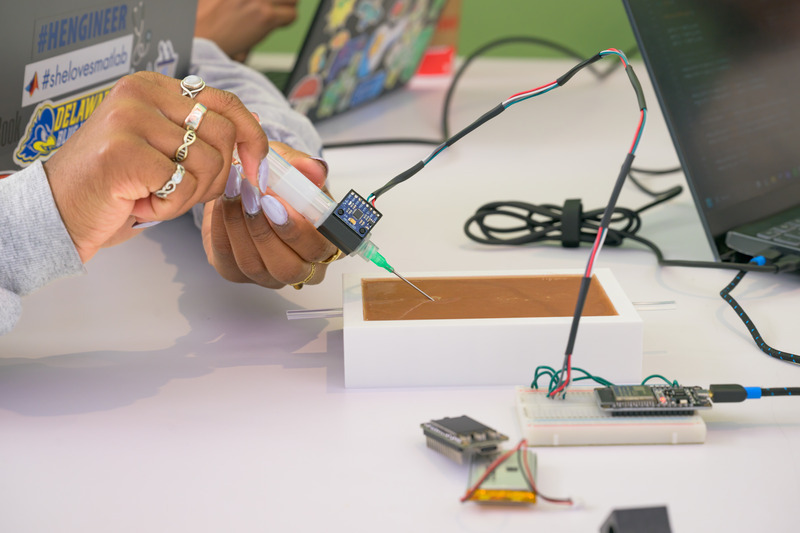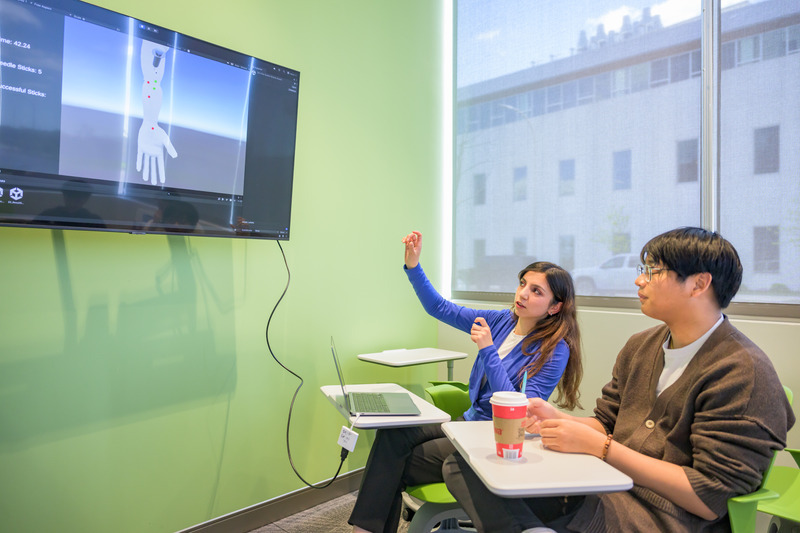

Simulated training tool for drawing blood: youtube.com/watch?v=qniQh40XNEk
Real-world experience right on campus
Photos by Evan Krape | Photo illustration by Jeffrey C. Chase | Video by Ally Quinn August 29, 2025
Spin-In students develop training tool for drawing blood
According to the American Clinical Laboratory Association (ACLA), approximately 7 billion blood draws take place each year in the United States.
For some individuals in need of such services, this activity comes with a heaping side of anxiety. Will the health care professional be successful in one try? Will it hurt? What if they can’t see the vein?
An interdisciplinary student team at the University of Delaware has developed a simulated training tool for drawing blood to improve nursing students’ readiness before they enter the workforce, as part of their Spin In program experience. The Spin In program is housed in UD’s Office of Economic Innovation and Partnerships (OEIP) and designed to expose students to the world of innovation and entrepreneurship, technology development, business development and commercialization.
The big idea: gamify the learning experience to improve the accuracy of nursing student blood draws in real life.
Working with industry mentor John Royer, CEO of InsiteHub, an educational and training software development company, the student team came up with a training platform that included a needle equipped with sensors that would register how close the needle came to a “vein” represented by a copper wire embedded in a silicone skin model. The sensor data could be displayed on a computer software program to help future health care professionals visualize how well they performed over successive attempts.
Getting started
As part of their work, the InsiteHub team surveyed health care professionals, mainly nursing students and professors in UD’s College of Health Sciences, about whether they have been stuck more than once by a health care professional during a blood draw. Anecdotal evidence and survey data indicated many had. The team also visited UD’s Health Care Theater and watched nursing students perform blood draws on each other and on a dummy model with fake veins and blood. The students realized that for some training tools, such as the model with fake veins, repeated use can leave visible targets for where to insert the needle.
This led biomedical engineering students Kira Byer and Gianna Dowling to investigate different materials with self-healing properties to prevent students from following others’ attempts. The pair 3D printed a form for making the skin analog and used off-the-shelf, self-healing silicone materials to mimic the skin.

“For our product, we wanted to create a device that helps with insertion of the needle, because one of the biggest problems is just getting the needle in the right spot. Then we came up with our device, which is a self-closing silicone arm/vein,” said Dowling, who earned her biomedical engineering degree from UD in May.
Equipping the practice needle with sensors connected to a computer program over Wi-Fi or Bluetooth provides real-time feedback about the quality of the practicing student’s blood draw. For example, did the student place the needle in the correct spot and at the correct angle to effectively reach the vein?
“Maybe out of 10 practice sticks the student got six correct. We wanted to have a user interface that says, this is what your simulation looked like, and this is how you scored,” said Khai McCaskill, a computer engineering major. “Being able to see how you did the last time you practiced and learn from that is huge.”
The ultimate goal is to reduce anxiety for the consumer who needs their blood drawn. Secondary to this is improving the skills and techniques for practitioners, so they can perform blood draws with confidence and accuracy even under challenging circumstances.

One nuance that came to light during surveys was that it is harder to see the veins of individuals with dark skin tones. So, the students created silicone skin model samples of varying skin tones for nursing students to practice developing intuitive knowledge on how to perform the procedure. For example, palpating a patient’s skin to determine the right vein to use, rather than relying on visual confirmation of the vein’s appearance under the skin.
Meanwhile, software developers on the team worked on the back end of the training app to develop a prototype game scene and capture user performance information on successful/unsuccessful tries that can be displayed at the end of each turn. Each successful stick is represented by a green dot and unsuccessful sticks by a red dot, to give users feedback where they were and were not successful. Other members of the team worked on the business and marketing end, including aspects of branding and packaging.
Byers, who graduated in May with a degree in biomedical engineering, pointed to learning how to write a patent claim as novel experience that would positively impact her career. “It has set me apart during job interviews,” she said.
Meanwhile, Brishna Nazari, a software development specialist on the project, enjoyed the interdisciplinary team environment. “Working with people from different departments, innovating something new that would help people and students gives me a really good feeling.”

The team presented their work during the Spin In Showcase, held annually in May, and they have spun their work back out to Royer at InsiteHub, who will decide whether to move forward and commercialize it.
“It’s wonderful to see the students learn how to self-assemble, collaborate and develop and make recommendations. They hold each other accountable, while learning the interdependencies of working in a team environment and furthering their project along the commercialization pathway,” said Amalea Rassias, program director for Spin In and OEIP assistant director.
Two other student Spin In teams shared their recommendations at the showcase. A second team worked with Asate AG, a medical company in Switzerland that makes a novel therapy device for sleep apnea disorders. Called Silent Sleep Training therapy, the device is paired with an app that provides real-time data and teaches users circular breathing techniques to strengthen upper airway muscles, reduce airway collapse during sleep and improve sleep quality over time. The Silent Sleep Training Spin In team performed market research, helped define the device’s value proposition and explored ways to help the company demonstrate the devices’ effectiveness, while meeting customers’ needs and growing its market presence.
The third team worked with Innovative Precision Health (IPH), a health care technology company that uses artificial intelligence and machine learning to help patients and providers understand complex medical data. The IPH Spin In team was charged with building a patient-facing app to help better organize health care analytics data. This included customizing the user interface and features to meet patient needs, considering a look and feel that would be easy for patients to use and developing pricing strategies to encourage patient adoption and use of the product.
About Spin In
Spin In is a unique UD offering funded by the U.S. Economic Development Administration’s University Center Economic Development program to advance workforce development in the state and region.
Contact Us
Have a UDaily story idea?
Contact us at ocm@udel.edu
Members of the press
Contact us at 302-831-NEWS or visit the Media Relations website

